Ultra-Wideband Low-Cost High-Efficiency Cavity-Backed Compound Spiral Antenna
Abstract
:1. Introduction
2. Antenna Structure and Design Approach
2.1. Compound Spiral
2.2. Center Raised Cylindrical Cavity
2.3. Balun
3. Results
3.1. Frequency-Domain Performance
3.2. Time–Domain Performance
4. Conclusions
Author Contributions
Funding
Conflicts of Interest
References
- Sachs, J. Handbook of Ultra-Wideband Short-Range Sensing: Theory, Sensors, Applications; Wiley-VCH Verlag & Co. KGaA: Weinheim, Germany, 2012. [Google Scholar]
- Nguyen, C.; Han, J. Time-Domain Ultra-Wideband Radar, Sensor and Components; Springer: Berlin/Heidelberg, Germany, 2014. [Google Scholar]
- Taylor, J.D. Ultrawideband Radar: Applications and Design; CRC Press: Boca Raton, FL, USA, 2016. [Google Scholar]
- Dyson, J.D. A survey of the very wide band and frequency independent antennas—1945 to the present. J. Res. Nat. Bur. Stand.–(Radio Propag.) 1962, 66, 1–6. Available online: https://nvlpubs.nist.gov/nistpubs/jres/66d/jresv66dn1p1_a1b.pdf (accessed on 27 August 2020). [CrossRef] [Green Version]
- Curtis, W. Spiral antennas. IRE Trans. Antennas Propag. 1960, 8, 289–306. [Google Scholar] [CrossRef]
- Rumsey, V.H. Frequency Independent Antennas; Academic Press: Cambridge, MA, USA, 1966. [Google Scholar]
- Corzine, R.G.; Mosko, J.A. Four-Arm Spiral Antennas; Artech House: Norwood, MA, USA, 1990. [Google Scholar]
- DuHamel, R.H.; Chadwick, G.G. Frequency-independent antennas. In Antenna Engineering Handbook, 2nd ed.; Johnson, R.C., Jasik, H., Eds.; McGraw-Hill Book Company: New York, NY, USA, 1984; Chapter 14; pp. 14-16–14-26. [Google Scholar]
- Filipović, D.S.; Cencich, T. Frequency-independent antennas. In Antenna Engineering Handbook, 4th ed.; Volakis, J.L., Ed.; Mc-Graw-Hill: New York, NY, USA, 2007; Chapter 13. [Google Scholar]
- Nakano, H. Frequency-independent antennas: Spirals and log-periodics. In Modern Antenna Handbook; Balanis, C.A., Ed.; Wiley Online Library: Hoboken, NJ, USA, 2007; Chapter 6. [Google Scholar]
- Stutzman, W.L.; Thiele, G.A. Antenna Theory and Design, 3rd ed.; Wiley: Hoboken, NJ, USA, 2013. [Google Scholar]
- Balanis, C.A. Antenna Theory: Analysis and Design, 4th ed.; Wiley: Hoboken, NJ, USA, 2013. [Google Scholar]
- Sheen, D.; McMakin, D.; Hall, T. Near-field three-dimensional radar imaging techniques and applications. Appl. Opt. 2010, 49, E83–E93. [Google Scholar] [CrossRef] [PubMed]
- Volakis, J.L.; Nurnberger, M.W.; Filipović, D.S. Broadband cavity-backed slot spiral antenna. IEEE Antennas Propag. Mag. 2001, 43, 15–26. [Google Scholar] [CrossRef]
- McFadden, M.; Scot, W. Analysis of the equiangular spiral antenna on a dielectric substrate. IEEE Trans. Antennas Propag. 2007, 55, 3163–3171. [Google Scholar] [CrossRef]
- McFadden, M. Analysis of the Equiangular Spiral Antenna. Ph.D. Thesis, School of Electrical and Computer Engineering, Georgia Institute of Technology, Atlanta, GA, USA, 2009. [Google Scholar]
- Fumeaux, C.; Baumann, D.; Vahldieck, R. Finite-volume time-domain analysis of a cavity-backed Archimedean spiral antenna. IEEE Trans. Antennas Propag. 2006, 54, 844–851. [Google Scholar] [CrossRef]
- Nakano, H.; Nogami, K.; Arai, S.; Mimaki, H.; Yamauchi, J. A spiral antenna backed by a conducting plane reflector. IEEE Trans. Antennas Propag. 1986, 34, 791–796. [Google Scholar] [CrossRef]
- Nakano, H.; Soga, H.; Honma, T.; Yamauchi, J. Effects of adding a small disk to a spiral antenna backed by a conducting plane reflector. IEE Proc. H Microwaves Antennas Propag. 1991, 138, 375–377. [Google Scholar] [CrossRef]
- Nakano, H.; Kikkawa, K.; Iitsuka, Y.; Yamauchi, J. Equiangular spiral antenna backed by a shallow cavity with absorbing strips. IEEE Trans. Antennas Propag. 2008, 56, 2742–2747. [Google Scholar] [CrossRef] [Green Version]
- Serhir, M.; Guinvarc’h, R. A low-profile cavity-backed dual-polarized spiral antenna array. IEEE Antennas Wirel. Propag. Lett. 2013, 12, 524–527. [Google Scholar] [CrossRef]
- Sammeta, R.; Filipović, D.S. Quasi frequency-independent increased bandwidth planar log-periodic antenna. IEEE Trans. Antennas Propag. 2014, 62, 1937–1944. [Google Scholar] [CrossRef]
- Sheikh, Z.; Tahir, F.A. Gain enhancement of low profile cavity backed spiral antenna at low frequencies. In Proceedings of the Progress of the 2017 Progress in Electromagnetics Research Symposium-Fall (PIERS-FALL), Singapore, 19–22 November 2017; pp. 1771–1773. [Google Scholar]
- Hamza, M.; Khan, W.T. Hybrid utilization of loading techniques and cavity groove for performance enhancement of the UWB (2–18 GHz) spiral antenna. Int. J. Antennas Propag. 2018, 2018, 9167154. [Google Scholar] [CrossRef]
- Acree, M.A.; Prata, A. Archimedean spiral-mode microstrip antenna with improved axial ratio. In Proceedings of the IEEE AP-S/URSI International Symposium on Antennas and Propagation, Orlando, FL, USA, 11–16 July 1999; Volume 2, pp. 1232–1235. [Google Scholar]
- Liu, C.; Lu, Y.; Du, C.; Cui, J.; Shen, X. The broadband spiral antenna design based on hybrid backed-cavity. IEEE Trans. Antennas Propag. 2010, 58, 1876–1882. [Google Scholar]
- Buck, M.C.; Filipović, D.S. Spiral cavity backing effects on pattern symmetry and modal contamination. IEEE Antennas Wirel. Propag. Lett. 2006, 5, 243–246. [Google Scholar] [CrossRef]
- Ding, F.; Zhang, F.; Zhang, Y. The broadband composite structure spiral antenna with a ladder-shaped backed-cavity. In Proceedings of the 2011 4th IEEE International Symposium Microwave, Antenna, Propagation and EMC Technologies for Wireless Communications, Beijing, China, 1–3 November 2011; pp. 120–123. [Google Scholar]
- Shire, A.M.; Jahun, K.I.; Ashwal, W.A.; Jenu, M.Z.M.; Ramli, K.N. Effects of cavity ground plane on UWB Archimedean spiral antenna. In Proceedings of the 2015 IEEE International Conference on Computer, Communication, and Control Technology (I4CT 2015), Sarawak, Malaysia, 21–23 April 2015. [Google Scholar]
- Kim, H.-B.; Hwang, K.-C.; Kim, H.-S. Cavity-backed two-arm spiral antenna with a ring-shaped absorber for partial discharge diagnosis. J. Electr. Eng. Technol. 2013, 8, 856–862. [Google Scholar] [CrossRef]
- Louertani, K.; Chio, T.-H. Hybrid equi-angular to Archimedean spiral antenna. In Proceedings of the 2012 IEEE International Symposium on Antennas and Propagation, Chicago, IL, USA, 8–14 July 2012. [Google Scholar]
- Wang, Y.; Wang, G.; Yu, Z. Design of a highly miniaturized compound spiral antenna. In Proceedings of the International Symposium on Signals, Systems and Electronics, Nanjing, China, 16–19 September 2010. [Google Scholar]
- Zhao, Y.; Hu, W. Design of a UWB unidirectional radiation compound spiral antenna. In Proceedings of the IEEE 6th International Symposium on Microwave, Antenna, Propagation, and EMC Technologies (MAPE), Shanghai, China, 28–30 October 2015. [Google Scholar]
- Chen, M.; Wang, G.; Zhou, S. Novel compound planar spiral antenna. In Unifying Electrical Engineering and Electronics Engineering: Proceedings of the 2012 International Conference on Electrical and Electronics Engineering; Springer: Berlin/Heidelberg, Germany, 2013; pp. 1493–1500. [Google Scholar]
- Maldonado-Vargas, J.; Rodríguez-Solís, R.A.; Elmansouri, M.A.; Filipovic, D.S. A UWB cavity-backed compound power-Archimedean slot spiral for body centric wireless communications applications. In Proceedings of the IEEE AP-S/URSI International Symposium on Antennas and Propagation, Vancouver, BC, USA, 19–25 July 2015; pp. 1978–1979. [Google Scholar]
- Zhu, Y.-X.; Zhong, S.-S.; Xu, S.-Q. Miniaturized compound spiral slot antenna. Microw. Opt. Tech. Lett. 2008, 50, 2799–2801. [Google Scholar]
- Elmansouri, M.A.; Filipovic, D.S. Low-dispersion spiral antennas. IEEE Trans. Antennas Propag. 2012, 60, 5522–5530. [Google Scholar] [CrossRef]
- ANSYS HFSS (19.2.0), ANSYS. Available online: https://www.ansys.com/products/electronics/ansys-hfss (accessed on 17 September 2019).
- CST Studio Suite. Dassault Systèmes. 6–15 June 2018. Available online: https://www.3ds.com/products-services/simulia/products/cst-studio-suite/ (accessed on 17 September 2019).
- Wheeler, H.A. Transmission-line properties of parallel strips separated by a dielectric sheet. IEEE Trans. Microw. Theory Tech. 1965, 13, 172–185. [Google Scholar] [CrossRef]
- Quintero, G.; Zurcher, J.; Skrivervik, A. System fidelity factor: A new method for comparing UWB antennas. IEEE Trans. Antennas Propag. 2011, 59, 2502–2512. [Google Scholar]
- Elmansouri, M.; Radway, M.; Filipović, D. Frequency- and time-domain performance of four-arm mode-2 spiral antennas. IEEE Trans. Antennas Propag. 2012, 60, 2627–2634. [Google Scholar] [CrossRef]
- Pitcher, A.D.; McCombe, J.J.; Eveleigh, E.A.; Nikolova, N.K. Compact transmitter for pulsed-radar detection of on-body concealed weapons. In Proceedings of the IEEE MTT-S International Microwave Symposium, Philadelphia, PA, USA, 10–15 June 2018. [Google Scholar]
- Nikolova, N.K.; Thayaparan, T. Ultra-Wideband (UWB) High-Resolution Noise Radar for Concealed Weapon Detection. Tech. Report DRDC-Ottawa TR 2013-160, Defence Research and Development Canada. February 2014. Available online: https://cradpdf.drdc-rddc.gc.ca/PDFS/unc231/p804019_A1b.pdf (accessed on 27 August 2020).
- Nikolova, N.K.; McCombe, J.J. On-Body Concealed Weapon Detection System. U.S. Patent No. 10,229,328, 12 March 2019. Available online: https://patentimages.storage.googleapis.com/0f/d5/1e/a1a32e2f905ec5/US20150379356A1.pdf (accessed on 27 August 2020).



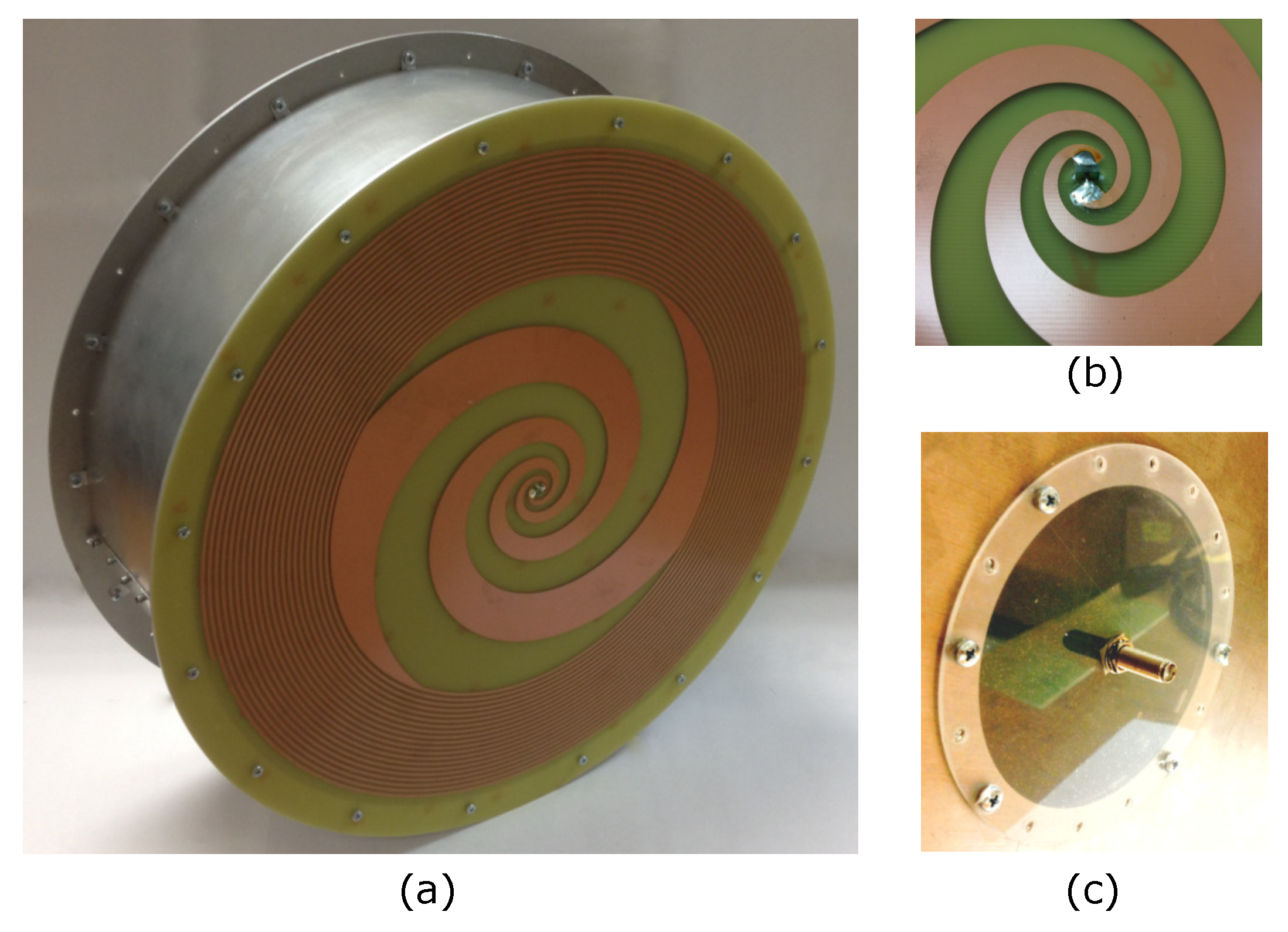
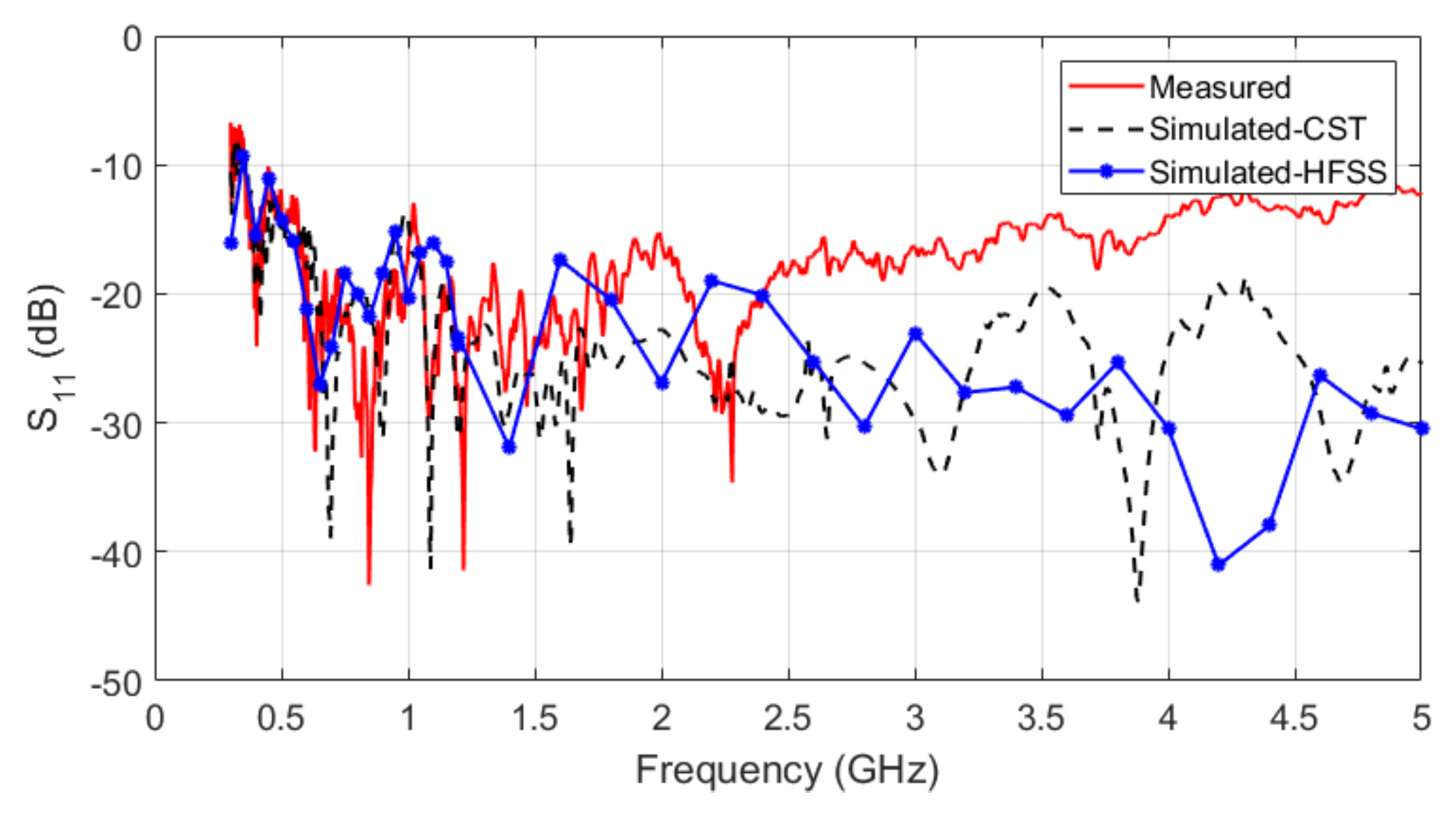
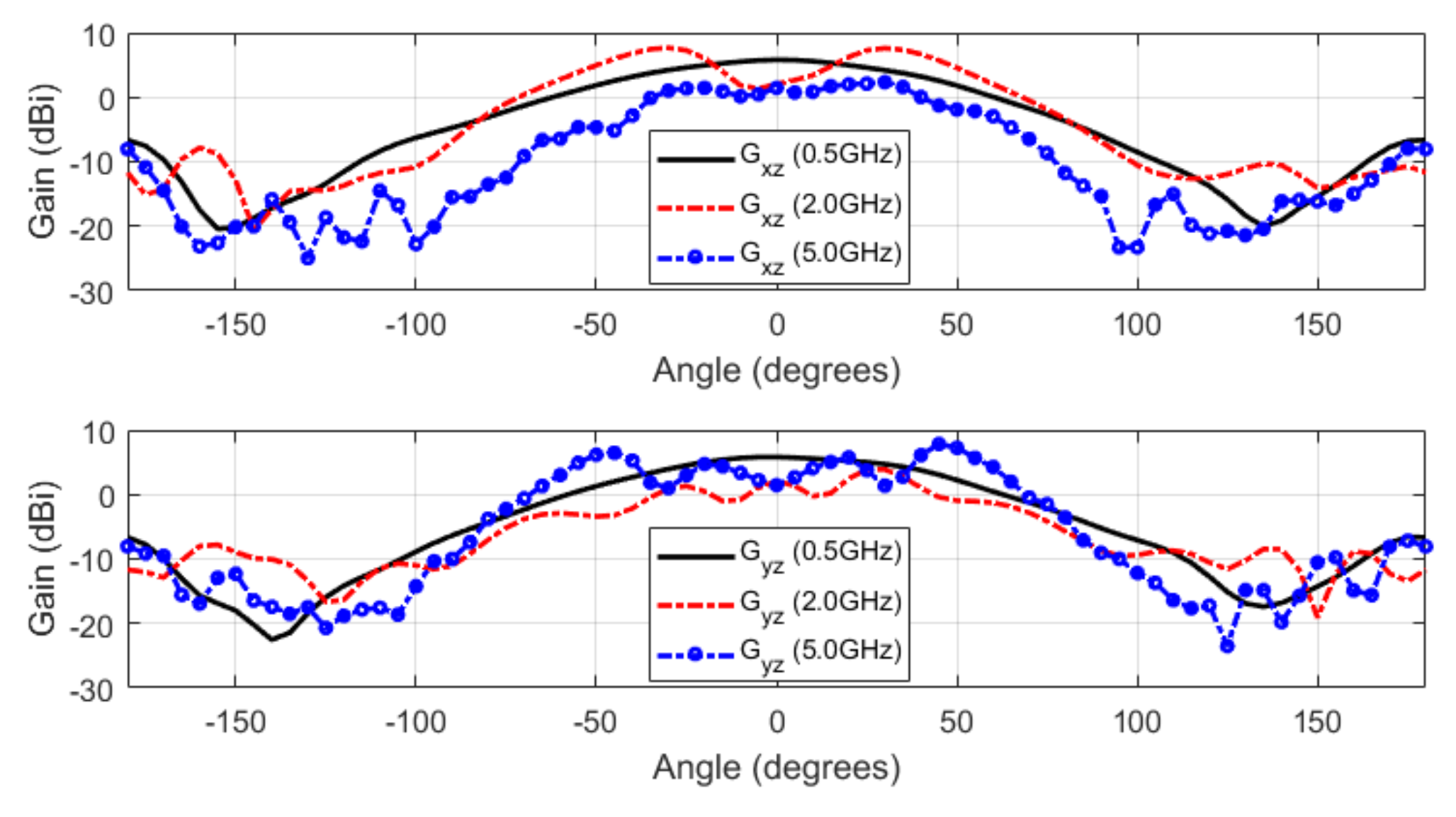

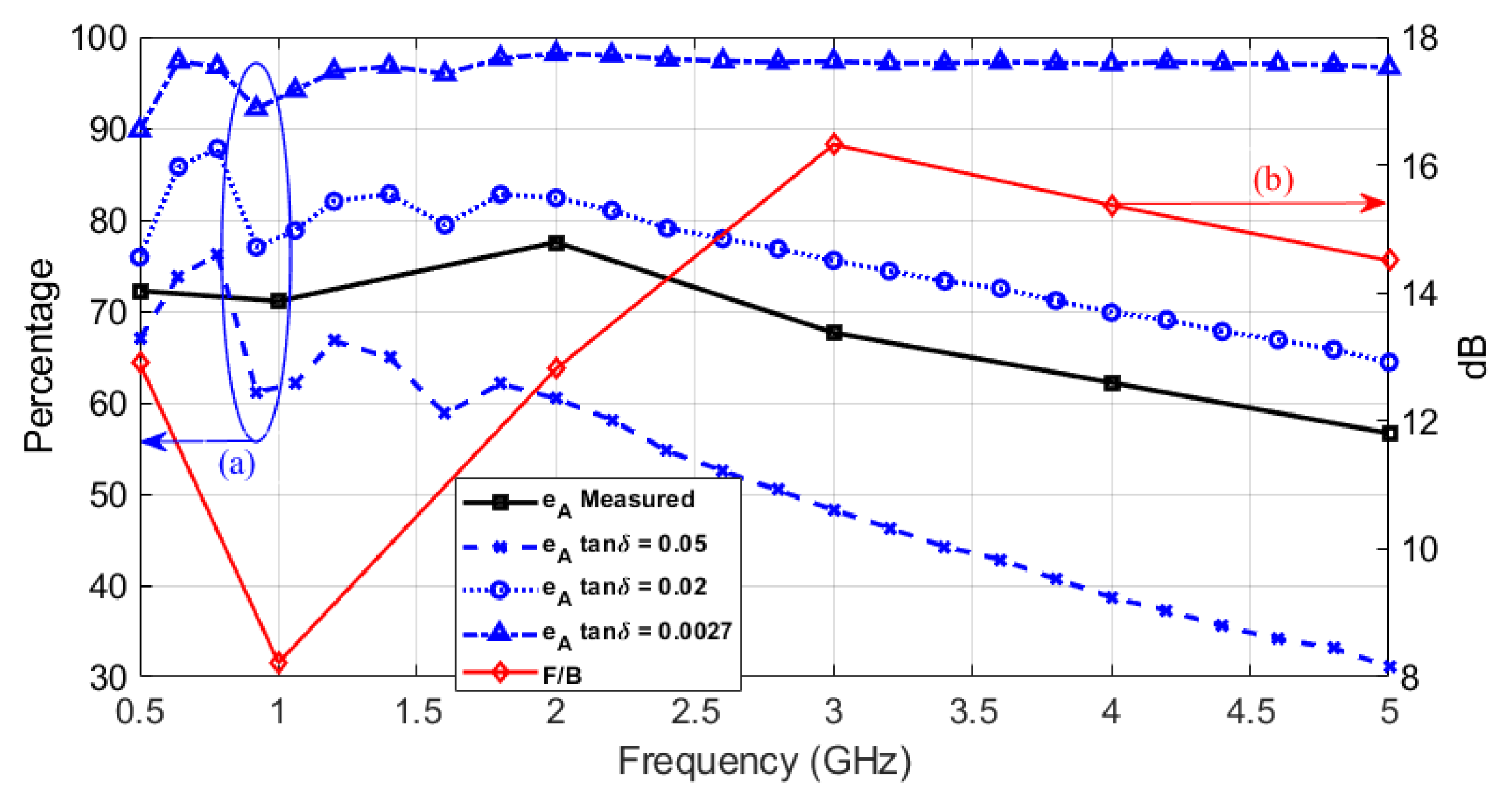
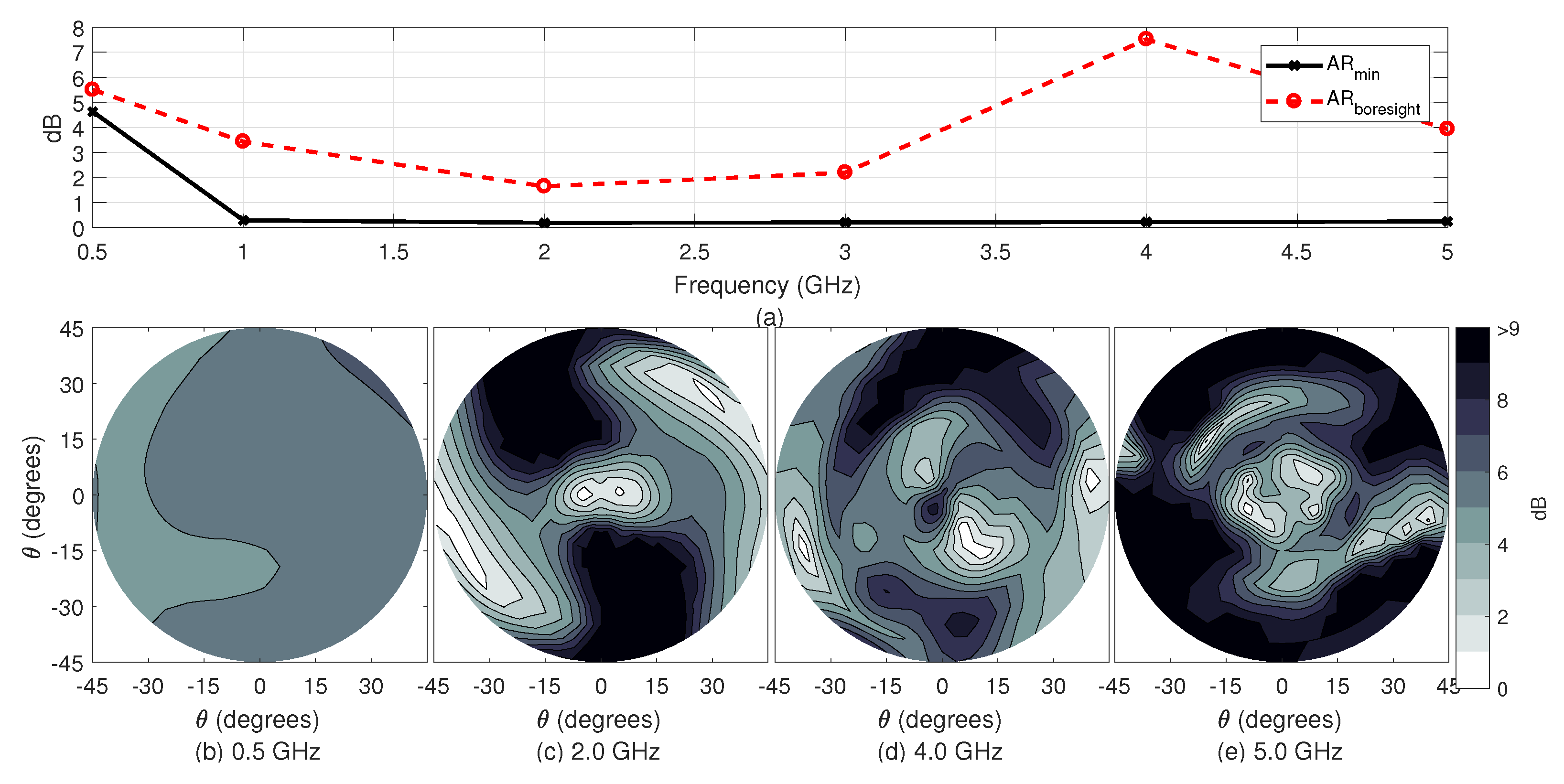

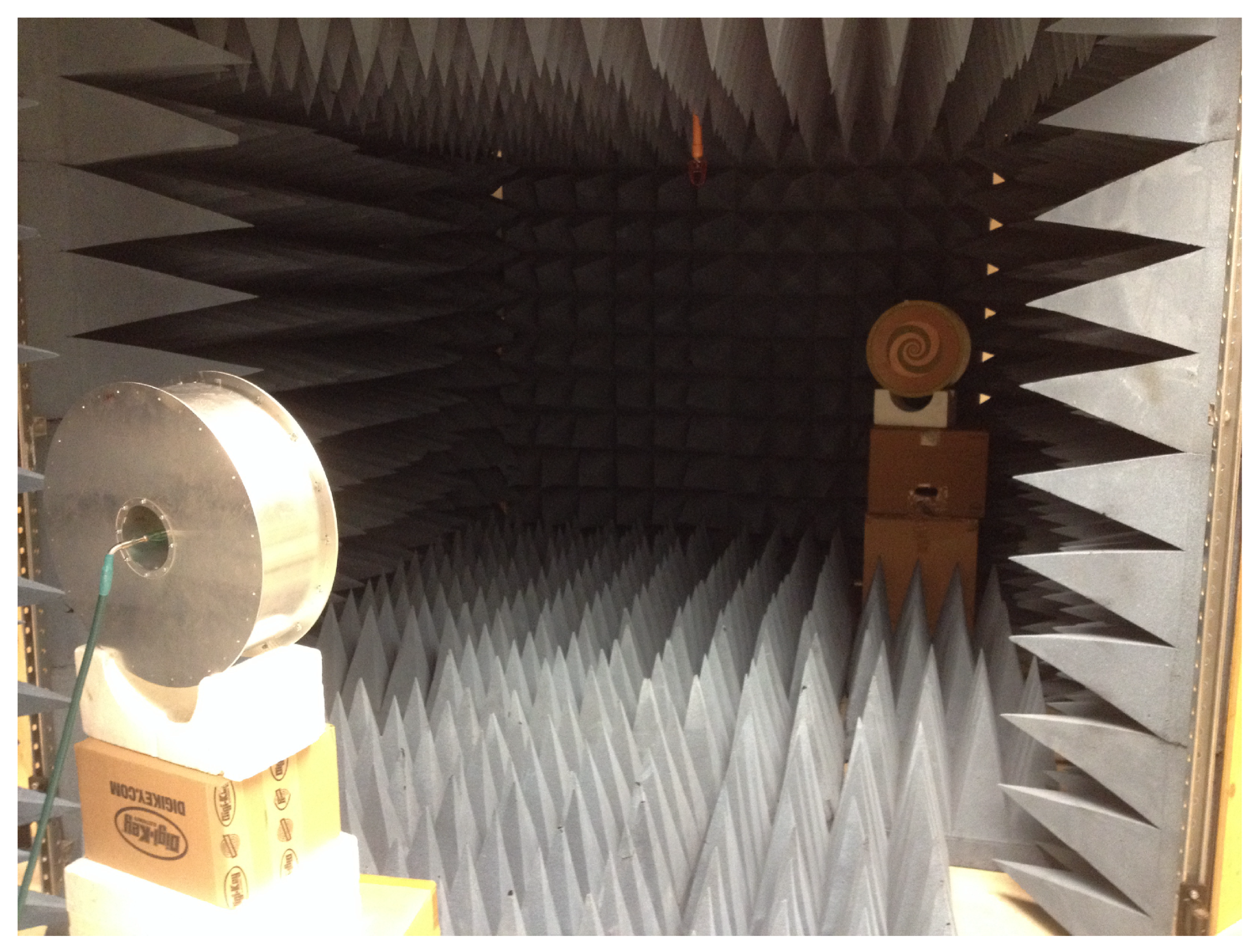
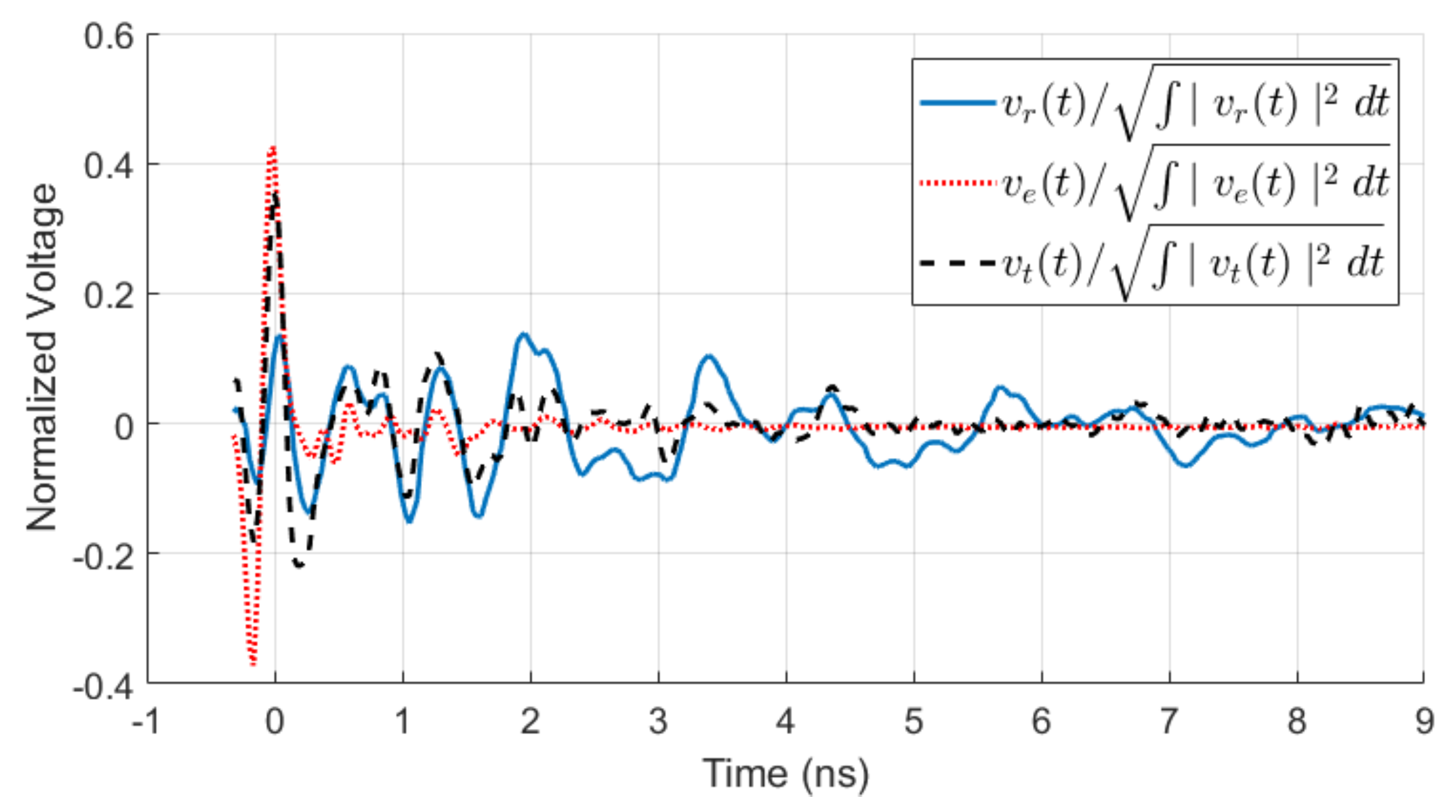
| Section | Length (mm) | Gradient Top | Gradient Bottom |
|---|---|---|---|
| 1 | 1.000 | 0.0000 | 0.0000 |
| 2 | 10.00 | ||
| 3 | 19.50 | ||
| 4 | 29.25 | ||
| 5 | 29.25 | ||
| 6 | 31.00 | ||
| 7 | 1.000 | 0.0000 | 0.0000 |
| Frequency (GHz) | 0.5 | 1.0 | 2.0 | 3.0 | 4.0 | 5.0 |
| Maximum (dBi) | 5.8 | 4.71 | 8.55 | 8.27 | 6.71 | 7.86 |
| Boresight (dBi) | 5.8 | 2.07 | 0.0093 | 1.14 |
© 2020 by the authors. Licensee MDPI, Basel, Switzerland. This article is an open access article distributed under the terms and conditions of the Creative Commons Attribution (CC BY) license (http://creativecommons.org/licenses/by/4.0/).
Share and Cite
Baard, C.; Liu, Y.; Nikolova, N. Ultra-Wideband Low-Cost High-Efficiency Cavity-Backed Compound Spiral Antenna. Electronics 2020, 9, 1399. https://doi.org/10.3390/electronics9091399
Baard C, Liu Y, Nikolova N. Ultra-Wideband Low-Cost High-Efficiency Cavity-Backed Compound Spiral Antenna. Electronics. 2020; 9(9):1399. https://doi.org/10.3390/electronics9091399
Chicago/Turabian StyleBaard, Charl, Yulang Liu, and Natalia Nikolova. 2020. "Ultra-Wideband Low-Cost High-Efficiency Cavity-Backed Compound Spiral Antenna" Electronics 9, no. 9: 1399. https://doi.org/10.3390/electronics9091399




